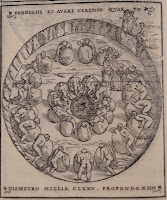
This Thursday, November 17th, Stephen Nichols of the Johns Hopkins University will give a lecture, "
Dartmouth's Rose Undying," on our 14th-century manuscript of the
Roman de la Rose. We are pretty infatuated with this manuscript, and have
blogged about it in the past. The lecture is free and open to the public and a reception will follow where you can see the manuscript in the flesh.
In addition to our manuscript copy, we have many editions of Chaucer's translation,
The Romaunt of the Rose. We have several 16th-century editions, and this one from 1687 with an interesting commentary:
 In this Book the Authour hath many glaunces at the Hypocrisie of the Clergy; whereby he got himself such hatred amongst them that Gerson, Chancellour of Paris, writeth thus of him: saith he, There was one called Johannes Meldinensis, who wrote a Book called, The Romaunt of the Rose; which Book if I only had, and that there were no more in the World, if I might have five hundred pound for the same, I would rather burn it than take the Money. He sayeth more, That if he thought the Authour thereof did not repent him for that Book before he dyed, he would vouchsafe to pray for him no more than he would for Judas that betrayed Christ.
In this Book the Authour hath many glaunces at the Hypocrisie of the Clergy; whereby he got himself such hatred amongst them that Gerson, Chancellour of Paris, writeth thus of him: saith he, There was one called Johannes Meldinensis, who wrote a Book called, The Romaunt of the Rose; which Book if I only had, and that there were no more in the World, if I might have five hundred pound for the same, I would rather burn it than take the Money. He sayeth more, That if he thought the Authour thereof did not repent him for that Book before he dyed, he would vouchsafe to pray for him no more than he would for Judas that betrayed Christ.
To take a look, ask for
Val 823 C39 I16. The Manuscript is
Codex MS 003206.
 Very few people today would read Dante's Divine Comedy as literal truth, but Renaissance commentaries, especially those that emerged from Florence and Venice, often treated the poem as a divinely inspired work. A close reading of Dante could reveal the structure of the heavens and hell. The following images come from Alessandro Vellvtello's "Descriptione de lo Inferno" in Dante con l'espositioni di Christoforo Landino, et d'Alessandro Vellvtello (Venice: Appresso Giouamnattista, Marchio Sessa, et fratelli, 1578).
Very few people today would read Dante's Divine Comedy as literal truth, but Renaissance commentaries, especially those that emerged from Florence and Venice, often treated the poem as a divinely inspired work. A close reading of Dante could reveal the structure of the heavens and hell. The following images come from Alessandro Vellvtello's "Descriptione de lo Inferno" in Dante con l'espositioni di Christoforo Landino, et d'Alessandro Vellvtello (Venice: Appresso Giouamnattista, Marchio Sessa, et fratelli, 1578).





